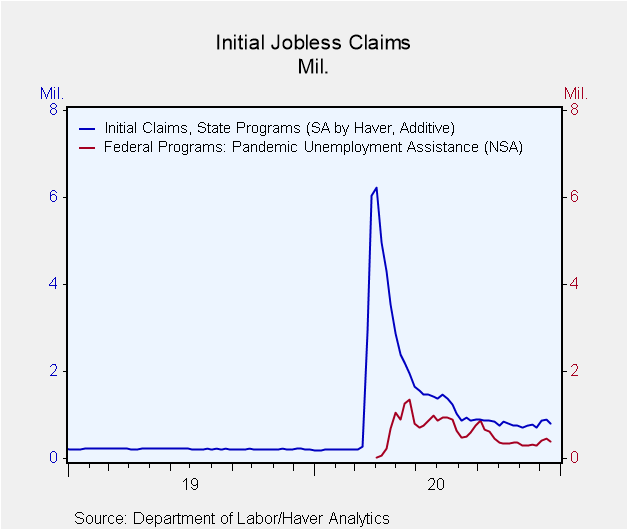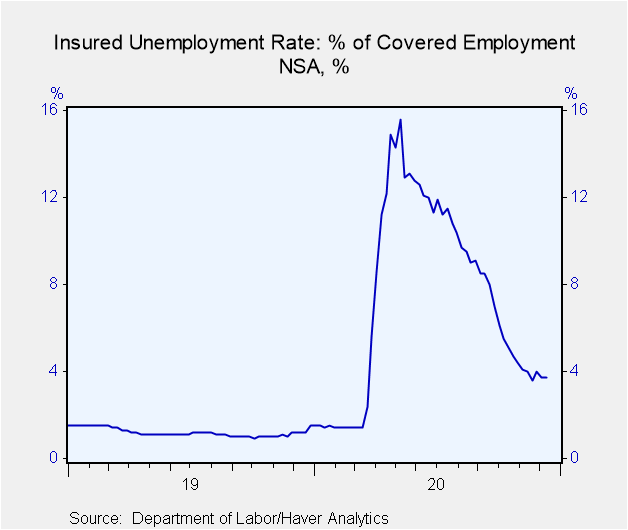 Global| Dec 23 2020
Global| Dec 23 2020U.S. Initial Jobless Claims Fall for Both Regular and PUA Programs
Summary
• State initial claims reverse 2 prior weeks' increases. • PUA initial claims down in latest week, but still above November amounts. • Legislation for PUA and PEUC is still in negotiation. Seasonally adjusted initial claims for [...]
• State initial claims reverse 2 prior weeks' increases.
• PUA initial claims down in latest week, but still above November amounts.
• Legislation for PUA and PEUC is still in negotiation.
Seasonally adjusted initial claims for unemployment insurance decreased to 803,000 in the week ended December 19 from 892,000 the week before; that earlier week was revised up from 885,000. The Action Economics Forecast Survey anticipated 863,000 new state claims in the latest week.
A change in the calculation of seasonal adjustment factors created a break in the series in late August. Though the current comparison to early September is valid, comparisons to before August 22 are not. Haver Analytics has calculated methodologically-consistent seasonally adjusted claims going back to 1979. This series matches the Department of Labor seasonally adjusted series since the change in methodology. For more details, please see the September 3 commentary on jobless claims.
Initial claims for the federal Pandemic Unemployment Assistance (PUA) program, which covers individuals such as the self-employed who are not included in regular/state unemployment insurance, fell to 397,511 in the December 19 week from 454,471 the prior week. Note that the brief history of this program, just back to April 4, 2020, means these data and other COVID-related series are not seasonally adjusted.
Continuing claims for regular state unemployment insurance declined by 170,000 in the December 12 week to 5.337 million from 5.507 million the week before. Continuing PUA claims, which are lagged an additional week and not seasonally adjusted, increased another 26,556 to 9.271 million. Pandemic Emergency Unemployment Compensation (PEUC) claims rose to a new high of 4.801 million in the week ending November 28. This program covers people who were unemployed before COVID but exhausted their state benefits and are now eligible to receive an additional 13 weeks of unemployment insurance, up to a total of 39 weeks. Funding for both PUA and PEUC programs is set to expire on December 26, which means that at current levels, 14.0 million people would lose their benefits in January. Legislation covering these benefits is the subject of negotiations between Congress and President Trump that is ongoing as we write here today.
The seasonally adjusted state insured rate of unemployment declined to 3.6% in the week ended December 12 from 3.8%. The latest week is the lowest rate since March 21. These data do not include the federal pandemic assistance programs. If you include the latest data available, which is lagged one additional week, the total number of state, PUA and PEUC continuing claims decreased to 19.5 million or 13.4% of covered employment.
The state insured rates of unemployment – which do not include federal programs – continued to show wide variation with South Dakota still at just 0.9% and California at 6.6%. The largest states ranged between 1.8% for Florida and the 6.6% noted above for California; New York was 4.2% and Illinois 5.6%. The state rates are not seasonally adjusted.
Data on weekly unemployment claims going back to 1967 are contained in Haver's WEEKLY database, and they are summarized monthly in USECON. Data for individual states are in REGIONW. The expectations figure is from the Action Economics Forecast Survey, carried in the AS1REPNA database.
| Unemployment Insurance (SA, 000s) | 12/19/20 | 12/12/20 | 12/05/20 | Y/Y % | 2019 | 2018 | 2017 |
|---|---|---|---|---|---|---|---|
| Initial Claims | 803 | 892 | 862 | 268 | 218 | 221 | 244 |
| Initial Claims (NSA) | 869 | 942 | 957 | 203 | 218 | 221 | 243 |
| Initial Claims Pandemic Unemployment Assistance (NSA) | 398 | 454 | 415 | -- | -- | -- | -- |
| Continuing Claims | -- | 5,337 | 5,507 | 211 | 1,701 | 1,756 | 1,961 |
| Continuing Claims (NSA) | -- | 5,444 | 5,492 | 203 | 1,704 | 1,763 | 1,964 |
| Continuing Claims Pandemic Unemployment Assistance (SA) | -- | -- | 9,271 | -- | -- | -- | -- |
| Insured Unemployment Rate (%) | -- | 3.6 | 3.8 |
1.2 |
1.2 | 1.2 | 1.4 |
Carol Stone, CBE
AuthorMore in Author Profile »Carol Stone, CBE came to Haver Analytics in 2003 following more than 35 years as a financial market economist at major Wall Street financial institutions, most especially Merrill Lynch and Nomura Securities. She has broad experience in analysis and forecasting of flow-of-funds accounts, the federal budget and Federal Reserve operations. At Nomura Securites, among other duties, she developed various indicator forecasting tools and edited a daily global publication produced in London and New York for readers in Tokyo. At Haver Analytics, Carol is a member of the Research Department, aiding database managers with research and documentation efforts, as well as posting commentary on select economic reports. In addition, she conducts Ways-of-the-World, a blog on economic issues for an Episcopal-Church-affiliated website, The Geranium Farm. During her career, Carol served as an officer of the Money Marketeers and the Downtown Economists Club. She has a PhD from NYU's Stern School of Business. She lives in Brooklyn, New York, and has a weekend home on Long Island.









